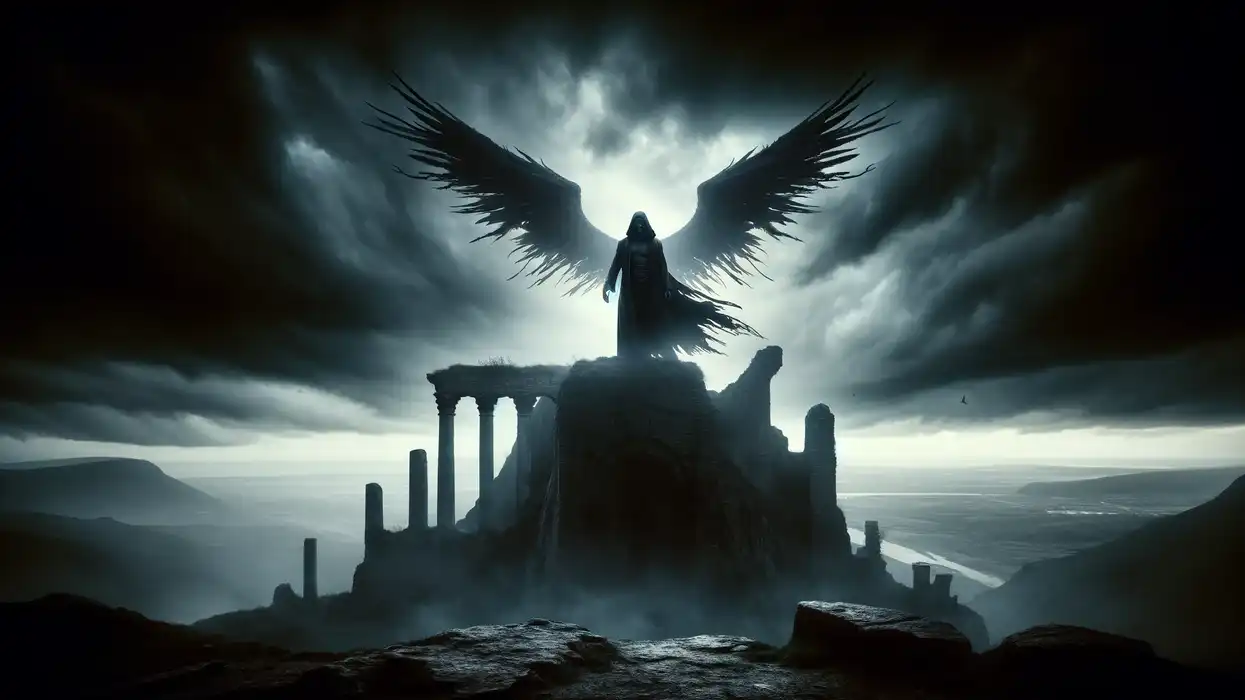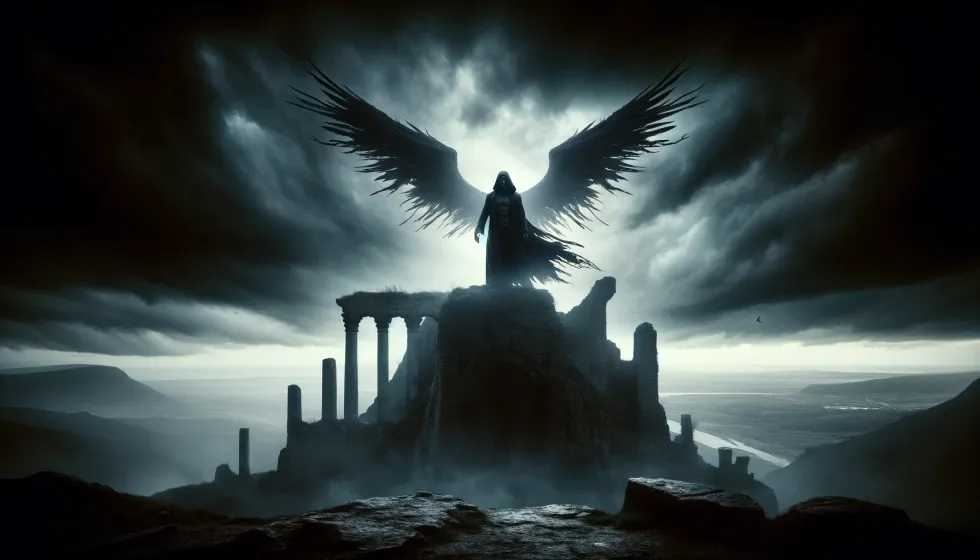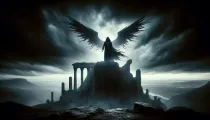95+ Fallen Angel Names You Need To Know

Content
- Popular Fallen Angel Names
- Fallen Angels That Control Legions Of Demons
- Fallen Angels With Multiple Forms
- Fallen Angels With Extraordinary Knowledge
- Fallen Angels Depicted As Animals
- Female Fallen Angels Names
- What differentiates fallen angels from evil spirits?
- Can fallen angels redeem themselves?
- Do all cultures have stories of fallen angels?
- Why are fallen angels so captivating?
- How do fallen angels influence humanity?
- What was Lucifer's angel name?
- Who are the 12 archangels?
- Who was the angel that betrayed God?
- What is a female angel called?
- What are the fallen angel names?
- Can you name a girl angel?
Have you ever been drawn to the mysterious tales of angels who took a stand and fell from their high places despite their power and glory? These are the stories of the fallen angels, once pure and revered celestial beings who stepped down from their posts.
Understanding the meaning of a fallen angel isn't just about knowing their names. It's also about peeling back the layers of mystique surrounding their legendary rebellions and their roles in age-old questions about good and evil.
In this article, you'll discover male and female fallen angel names that have sparked stories for generations, captivating and thrilling those who hear them. Fallen angels are a key part of many historical legends, and their names, laden with meaning, intrigue, and a touch of tragedy, still echo through time.
Popular Fallen Angel Names
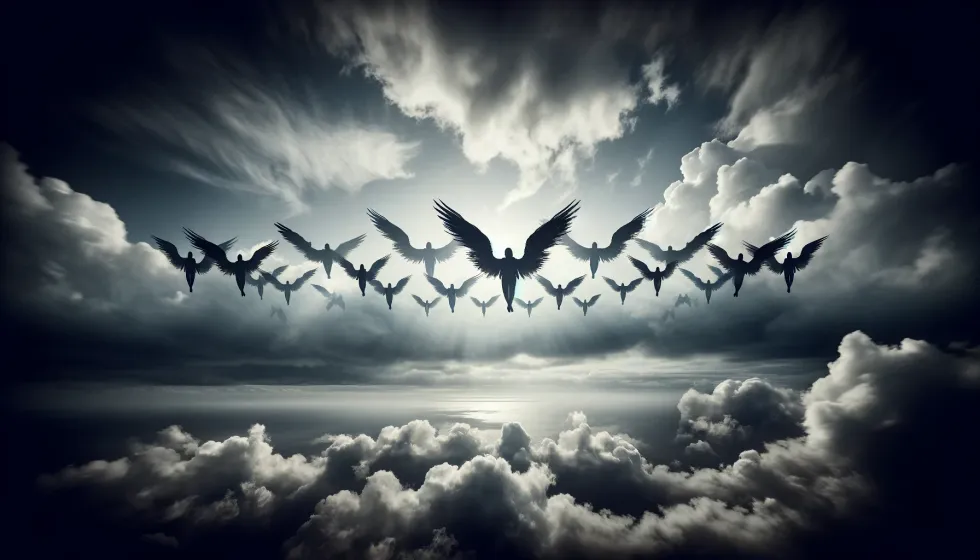
Have you ever thought about those mighty figures from tales of old, who were once sacred protectors but chose to rise and defy? Here, you'll learn about the fallen angel king and others who veered off the path of light. Each name belonging to a good but later turned evil fallen angel is more than just a label; it is a chronicle of might and daring, of a celestial order upturned.
1. Abaddon (Hebrew origin): means 'destruction' and is believed to be the chief of demons, embodying the abyss and ruin.
2. Amy: is known as a Great President of Hell with knowledge of astrology and the liberal arts. He is said to govern 36 legions of demons.
3. Abezethibou: is known as a one-winged fallen angel whose tale of rebellion and fall from grace is recounted in apocryphal texts.
4. Andromaleus: is a fallen angel believed to punish thieves.
5. Asmodeus (Persian origin): is known as one of the seven archangels in Zoroastrianism, symbolizing lust and wrath. His legend is rich in tales of deceit and the stirring of passions in the hearts of men.
6. Astaroth: is known as a Great Duke of Hell and part of an evil trinity alongside Beelzebub and Lucifer. Astaroth is believed to tempt men with promises of power and knowledge, leading them to destruction and eternal damnation.
7. Balberith: is also known as Berith. He is believed to be one of the high priests in the hierarchy of hell. He is also associated with the signing of demonic pacts and is frequently invoked during ritualistic ceremonies.
8. Barbatos: is known as a Duke and Earl of Hell, commanding 30 legions of demons. He is known for understanding the voices of animals, discerning the future, reconciling friends and rulers, and leading men to hidden treasures.
9. Beelzebub (Philistine origin): means 'lord of the flies'. Originally a Philistine deity, he is now mentioned in Christian demonology as a high-ranking fallen angel, embodying pestilence and considered a prince of demons.
10. Belial (Hebrew origin): means 'without worth'. Belial is believed to be a deceptively beautiful fallen angel often associated with lawlessness and worthlessness.
11. Berith (Canaanite origin): is also known as Baal Berith and has evolved from a worshipped deity to a symbol of deception.
12. Caim: is depicted as a man armed with a sword, often appearing with a thrush or blackbird on his shoulder, which can sing in a beautiful voice to answer questions truthfully.
13. Eligor: is known as a knight, signifying the fallen angels' battle against their fates and the order they fell from.
14. Focalor: is believed to command the sea and winds, drown men, sink ships, and stir up storms.
15. Furcas: is depicted as having a long beard and a cruel guise.
16. Gadreel (Hebrew origin): means 'my helper is God'. He is known as one of the Watchers (angels who fell after taking human wives and teaching humanity forbidden knowledge.)
17. Gomory: is often depicted as a beautiful woman riding a camel.
18. Halpas: is believed to build towers and fill them with ammunition and weapons, as well as send men to war.
19. Kimaris: is depicted as a godly warrior riding a black horse. Kimaris is also believed to uncover treasures and impart martial skills.
20. Kokabiel (Hebrew origin): means 'angel of the stars'. Kokabiel's name signifies celestial beauty and order, a direct contrast to the chaos often associated with the fallen.
21. Lerajie: is a fallen angel depicted as an archer.
22. Leviathan (Hebrew origin): is believed to be a monstrous creature from Jewish mythology. Leviathan embodies the earliest chaos and untamable forces of nature.
23. Lucifer (Latin origin): means 'light-bringer'. He is often described as the most renowned fallen angel and was once considered a symbol of light and beauty.
24. Mastema (Hebrew origin): means 'hostility'. Mastema is believed to persecute evil and test faith.
25. Mephistopheles (German origin): is a demon from German folklore known for shunning the light. He is believed to bargain for souls in exchange for worldly knowledge and power.
26. Naamah (Hebrew origin): means 'to please'. Naamah embodies the enticing qualities attributed to some fallen angels.
27. Paimon: is depicted as a crowned man riding a camel.
28. Phenex: is known as a Great Marquis of Hell who commands 20 legions of demons. He is believed to have expertise in sciences and poetry and shows great obedience to the conjuror.
29. Procel: is believed to reveal hidden and secret things.
30. Purah: is known as a demon of forgetfulness with the ability to conjure the dead, representing the manipulation of memory and reality.
31. Qemuel (Hebrew origin): is known as a fallen angel whose life was suddenly ended by divine decree.
32. Rahab (Hebrew origin): means 'violence'. Rahab's name evokes the chaotic and destructive forces often associated with these celestial beings in their interactions with the world.
33. Remiel (Hebrew origin): means 'God's thunder'.
34. Ruax: is a fallen angel believed to cause headaches.
35. Saleos: is a fallen angel depicted riding on a crocodile.
36. Satan: means 'adversary of God' and is believed to be the most infamous of all fallen angels.
37. Seere: is depicted as a man riding a winged horse.
38. Semyaza (Hebrew origin): is believed to be a son of God and one of the heavenly Watchers before becoming a fallen angel leader.
39. Uzza (Hebrew origin): means 'strength'. Along with Azael and Azza, he is known as one of the three primary ministering angels who lived in the seventh heaven before their fall.
40. Vepar: is known as a Duke of Hell with the power to summon storms.
41. Xaphan: is depicted as a fallen angel who set heaven ablaze and was cast out for his act of rebellion.
Fallen Angels That Control Legions Of Demons

In the unseen realms, there are fallen angels believed to command vast armies of demons. Each of these leaders has a name that echoes with authority and the power to rally countless spirits.
42. Amon: is known as a Grand Marquis of Hell and commands 40 legions.
43. Allocen: is known as a Duke of Hell commanding 36 legions and appears as a lion-headed warrior who breathes fire.
44. Beleth: is depicted as one of the most dreaded fallen angels commanding over 85 legions. He is known for his terrifying power and is said to ride a pale horse accompanied by trumpet sounds.
45. Botis: is depicted adorned with horns and fangs and is said to command 60 legions.
46. Decarabia: is known as a leader of 30 legions of demons and commands all birds.
47. Gaap: is known as a commander of over 66 demon legions, as a Great President of Hell, and as one of its seven princes.
48. Murmur: is depicted as a warrior riding a griffin. Murmur is believed to be the 54th spirit among Solomon's 72 spirits and commands 30 legions.
49. Naberius: is depicted as a fallen angel with great strength and a commander of 29 legions.
50. Vassago: is believed to have the ability to divine the future and the past and commands over 26 legions.
Fallen Angels With Multiple Forms
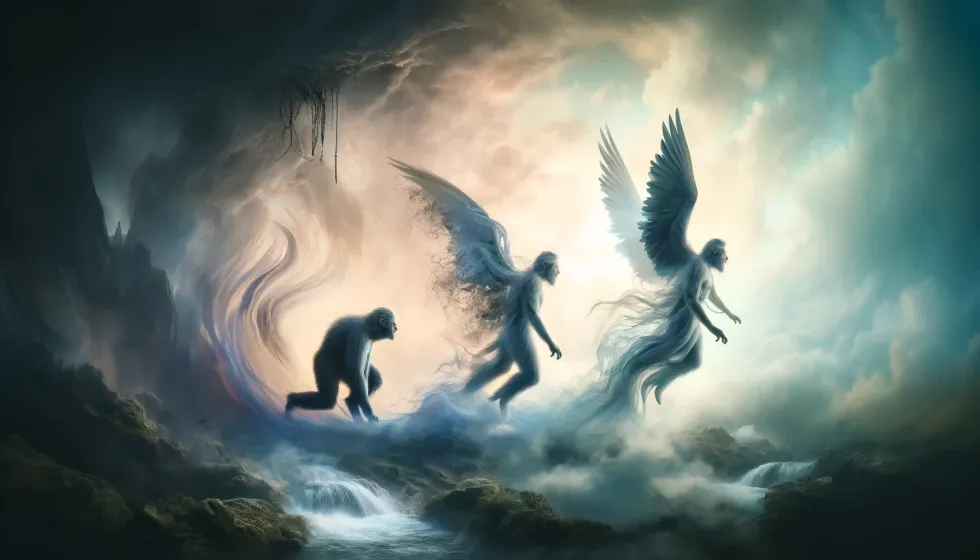
Some fallen angels are believed to have the ability to change shape. These shapeshifters can take on various appearances, revealing the complex and transformative nature of their existence.
51. Balam: is known as a Great King, Prince, and Duke of Hell, commanding 40 infernal legions. He is described as having three heads; that of a bull, a man, and a ram, along with a serpent's tail, and has the power to make men invisible. Balam is also believed to provide accurate answers about the past, present, and future.
52. Baal (Canaanite origin): is known as a Duke of Hell who rules over 66 legions of demons. He is often depicted as a man in various forms, including a man with the head of a cat, toad, or human, and sometimes with all three heads on one body.
53. Buer: is known as a demon who appears in the form of a star or a wheel. He teaches moral and natural philosophy, logic, and the virtues of all herbs and plants.
54. Enepsigos: is depicted as a woman with multiple forms. She's often associated with prophecy and revealing future events through dreams and visions.
55. Ipos: is known as a prince and Count of Hell who commands 36 legions of demons. He appears with the head of a lion, a goose's body, and a hare's tail, or as a human with similar features.
56. Valac: is also known as Ualac and believed to have a childlike appearance combined with dragon heads and wings.
57. Shax: is known as a Great Marquis of Hell who commands 30 legions.
58. Sabnack: is said to bear the powerful appearance of a soldier with a lion's head.
Fallen Angels With Extraordinary Knowledge
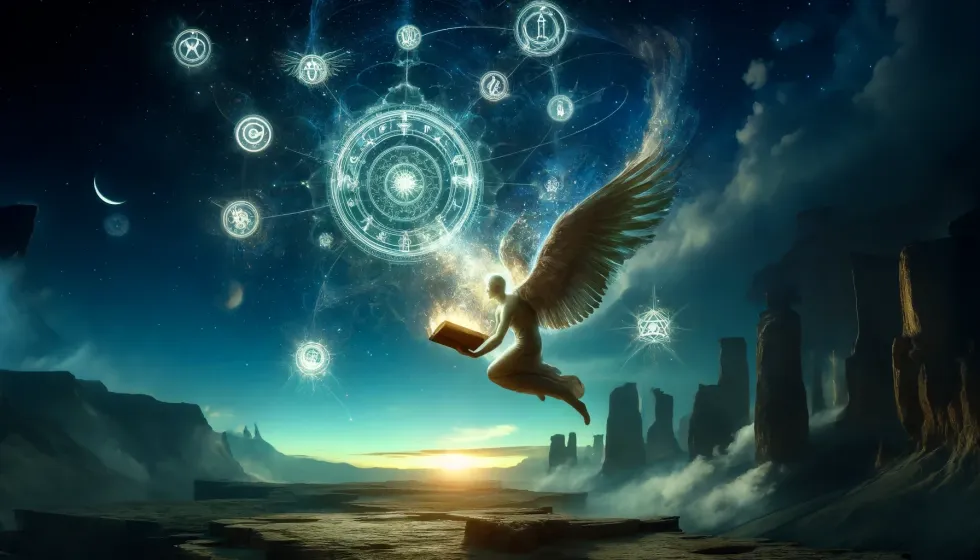
Among the fallen, certain beings hold the keys to wisdom far beyond the ordinary. Their names are synonymous with secrets and the kind of deep understanding that has influenced ages of seekers and scholars.
59. Azazel (Hebrew origin): is known as a fallen angel associated with the scapegoat ritual in ancient Judaism. Azazel is linked to forbidden knowledge and is often depicted as a mentor to humans in crafts and magic.
60. Armaros: is known as one of the leaders of the 200 Watchers, renowned for teaching humans how to undo magical spells and curses.
61. Bathin: is known as a Duke of Hell who commands 30 legions of demons. He is known for his knowledge of gemstones, herbs, and precious stones. He is depicted riding a pale horse and bearing a serpent's tail.
62. Baraqijal: is one of the fallen angels in the Book of Enoch. He is known for teaching astrology.
63. Belphegor: means 'lord of opening'. He is believed to tempt men with wealth and cleverness, offering brilliant inventions and discoveries and often depicted sitting on a toilet.
64. Bifrons: is known as a teacher of the mathematical arts.
65. Dantanian: is depicted as a fallen angel with the knowledge of all arts and sciences and the ability to change thoughts or influence decisions.
66. Forcas: is known as a teacher of ethics and logic.
67. Gusion: is depicted as a fallen angel with the ability to reveal the past, present, and future and reconcile friends and foes.
68. Ronobe: is depicted as a demon who knows the arts and languages. He is associated with the ability to grant favors to both friends and enemies and is said to provide good servants to those who summon him.
Fallen Angels Depicted As Animals
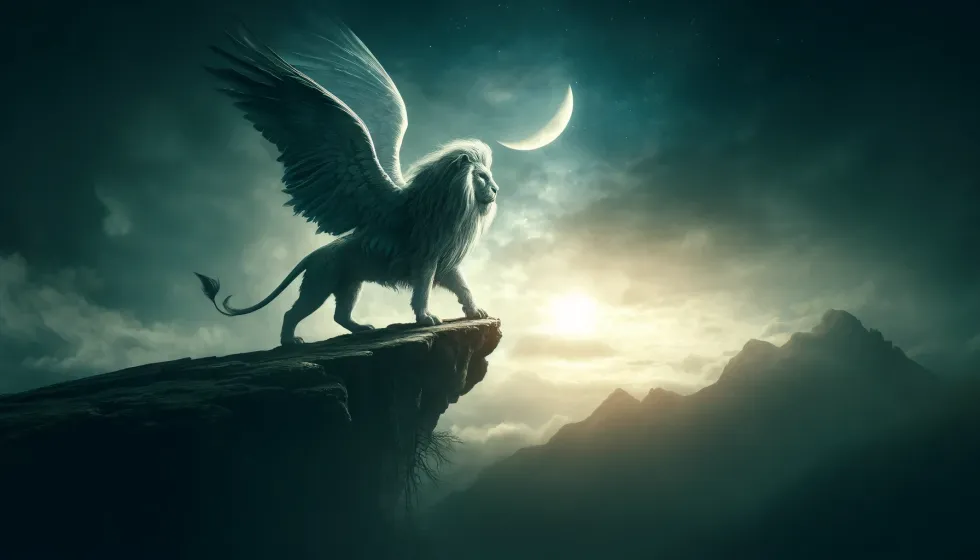
Many fallen angels are depicted with animal traits, a mix of the wild and the familiar. These images reflect their unique powers and the symbolic connections they have with the natural world.
69. Andrealphus: is known as a demon with the appearance of a peacock and the ability to transform people into birds.
70. Andras: is depicted as a raven-headed demon who is also in charge of 30 legions.
71. Amducias: is known as a Grand Duke of Hades with the appearance of a unicorn.
72. Behemoth (Hebrew origin): is a mythological beast featured in the Book of Job that represents ancient chaos. It's also described as a grass-eating animal with extraordinary strength.
73. Forneus: is known as a nobleman of hell with a sea monster-like appearance.
74. Flauros: is described as a fallen angel having a leopard-like appearance.
75. Gamygyn: is depicted as a tiny horse and is said to summon souls from the dead and communicate with them.
76. Glasyalabolas: is depicted as a dog with wings.
77. Hagenti: is described as a bull with the wings of a griffin.
78. Marbas: is known as a demon with a lion-shaped head.
79. Morax: is depicted as a bull.
80. Ose: is often depicted as a leopard.
81. Orobas: is described as a demon with a horse shape.
82. Orias: is depicted as a lion with a serpent's tail.
83. Ornias: is known as a demon with the ability to shape-shift.
84. Purson: is depicted as a man with a lion's head mounted on a bear.
85. Phoenix (Greek origin): is depicted as having a phoenix-like appearance and symbolizes rebirth and immortality.
86. Raum: is portrayed as a crow and commands 30 legions. Raum is associated with stealing treasures from kings, destroying cities and dignities, and causing love or hatred.
87. Solas: is believed to take the form of a raven and bridges the gap between the celestial and the infernal as a teacher of astronomy.
88. Sytry: is depicted as a leopard-headed man with griffin wings.
89. Valefor: is known as a Duke of Hell with a lion-like appearance.
90. Vapula: is known as a Duke of Hell with a lion-like form. He is renowned for teaching crafts, philosophy, and sciences.
91. Vine: is depicted as a demonic king with a lion's appearance riding a black horse.
92. Vual: is described as having a camel-like appearance.
93. Zagan: is known as a demon king who can transform water into wine. He is also described as having a bull-like appearance and wings.
Female Fallen Angels Names
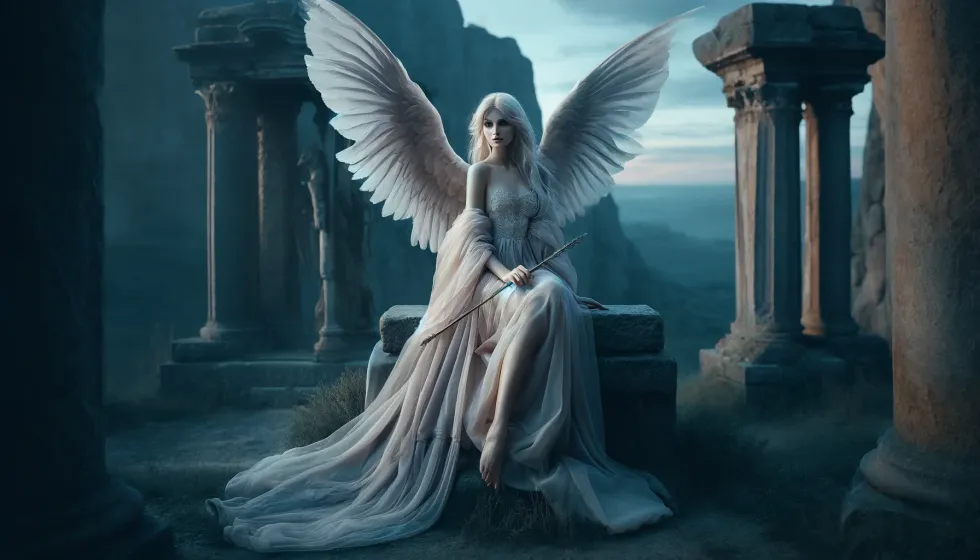
Are you curious about the legendary women of the celestial world whose choices altered their destinies? These fallen female angel names carry tales woven with enchantment and hidden whispers from the past.
94. Eisheth Zenunim (Jewish origin): means 'woman of whoredom'. Eisheth Zenunim is often associated with enticement and the corruption of human souls, using beauty as a weapon to deceive.
95. Gremory: is believed to be a powerful entity and one of the 72 Spirits of Solomon. She is known for her charming beauty and commands 26 legions of demons as a Duke of Hell. When she appears, she takes on the form of a beautiful woman with the crown of a duchess riding a camel.
96. Marchosias: is depicted as a she-wolf with griffin wings.
97. Obyzouth: is described as a demon often blamed for the sorrows of lost newborns and the sadness of childlessness.
98. Vepar: is depicted as a mermaid and is known as the Great Duchess of Hell, ruling over the waves and commanding 29 legions of demons.
FAQs
What differentiates fallen angels from evil spirits?
Fallen angels were once celestial beings who rebelled and were cast out of heaven, while evil spirits are often considered to be souls or entities with evil intentions. Fallen angels carry a backstory of rebellion and a complex relationship with divine will.
Can fallen angels redeem themselves?
In many religious and mythological traditions, fallen angels are beyond redemption, and their rebellion is seen as a permanent mark against them. However, stories and interpretations vary, with some viewing redemption as a possibility through a profound transformation.
Do all cultures have stories of fallen angels?
While the concept of fallen angels is most prominent in Abrahamic religions, similar themes of divine beings rebelling or being cast out can be found in various ancient cultures and mythologies, reflecting a universal fascination with the balance between good and evil.
Why are fallen angels so captivating?
Fallen angels depict the struggle between light and darkness, rebellion, and redemption. Their stories resonate with the human experience, mirroring humans' complex nature and contradictions, making them eternally fascinating figures.
How do fallen angels influence humanity?
In lore, fallen angels have been seen as bringers of knowledge, temptation, and even destruction. Their influence is often depicted as a double-edged sword, offering wisdom and power but at a potentially high cost.
What was Lucifer's angel name?
Before Lucifer became known as a symbol of rebellion, he was called the 'Morning Star' or 'bringer of light.' In many stories, this was his angelic name when he was considered a high-ranking figure of goodness before his fall.
Who are the 12 archangels?
While not all traditions agree on the number or names of archangels, some commonly recognized ones include Michael, Gabriel, Raphael, Uriel, Selaphiel, Raguel, Saraqael, Barachiel, Jegudiel, Metatron, Sandalphon, and Anael.
Who was the angel that betrayed God?
Lucifer is often the angel associated with betrayal in Christian tradition. His ambition led him to challenge God, which resulted in his fall from heaven.
What is a female angel called?
There is no specific word that distinguishes male from female angels in most religious texts, as angels are often seen as genderless beings. However, in art and literature, female angels are simply referred to as angels, just like their male counterparts.
What are the fallen angel names?
Some famous fallen angel names from various traditions include Lucifer, Leviathan, Beelzebub, Azazel, Lilith, Samyaza, and Gadreel.
Can you name a girl angel?
Yes, you can give a girl a name inspired by angels. Names like Angela, Angelica, Seraphina, Gabrielle, or Michaela are all derived from angelic names and can introduce a sense of grace and beauty associated with angelic beings.
Whether these fallen angel names have sparked caution or shared old secrets, they've always gripped people's imaginations and brought wonder throughout history. If curiosity brought you here, hopefully, you've discovered answers that make sense to you, giving you a clearer picture of these lasting mysteries.
We Want Your Photos!
More for You
Sources
See All
Bachelor of Science specializing in Computer Science

Christian MbaBachelor of Science specializing in Computer Science
Christian Mba is an experienced blogger and content writer with over a decade of experience. He holds a Bachelor of Science degree in Computer Science from Nigeria and has a keen interest in Python programming. Along with his writing and blogging expertise, he is also an SEO specialist with more than six years of experience. Chris, as he is commonly known, has a passion for music and enjoys playing the piano.
Bachelor of Arts and Law specializing in Political Science and Intellectual Property Rights

Anusuya MukherjeeBachelor of Arts and Law specializing in Political Science and Intellectual Property Rights
With a wealth of international experience spanning Europe, Africa, North America, and the Middle East, Anusuya brings a unique perspective to her work as a Content Assistant and Content Updating Coordinator. She holds a law degree from India and has practiced law in India and Kuwait. Anusuya is a fan of rap music and enjoys a good cup of coffee in her free time. Currently, she is working on her novel, "Mr. Ivory Merchant".
Disclaimer
1) Kidadl is independent and to make our service free to you the reader we are supported by advertising. We hope you love our recommendations for products and services! What we suggest is selected independently by the Kidadl team. If you purchase using the Buy Now button we may earn a small commission. This does not influence our choices. Prices are correct and items are available at the time the article was published but we cannot guarantee that on the time of reading. Please note that Kidadl is a participant in the Amazon Services LLC Associates Program, an affiliate advertising program designed to provide a means for sites to earn advertising fees by advertising and linking to Amazon. We also link to other websites, but are not responsible for their content.
2) At Kidadl, we strive to recommend the very best activities and events. We will always aim to give you accurate information at the date of publication - however, information does change, so it’s important you do your own research, double-check and make the decision that is right for your family. We recognise that not all activities and ideas are appropriate for all children and families or in all circumstances. Our recommended activities are based on age but these are a guide. We recommend that these ideas are used as inspiration, that ideas are undertaken with appropriate adult supervision, and that each adult uses their own discretion and knowledge of their children to consider the safety and suitability. Kidadl cannot accept liability for the execution of these ideas, and parental supervision is advised at all times, as safety is paramount. Anyone using the information provided by Kidadl does so at their own risk and we can not accept liability if things go wrong.
3) Because we are an educational resource, we have quotes and facts about a range of historical and modern figures. We do not endorse the actions of or rhetoric of all the people included in these collections, but we think they are important for growing minds to learn about under the guidance of parents or guardians.
